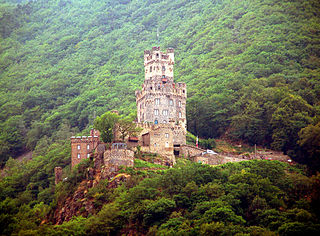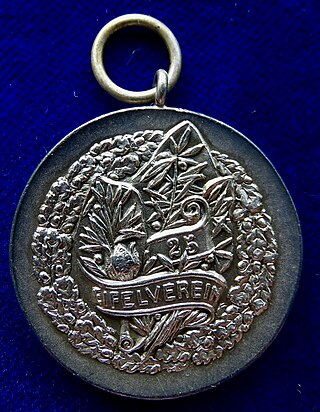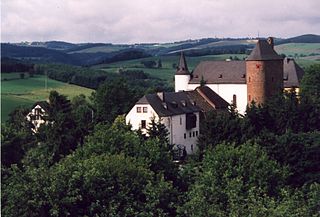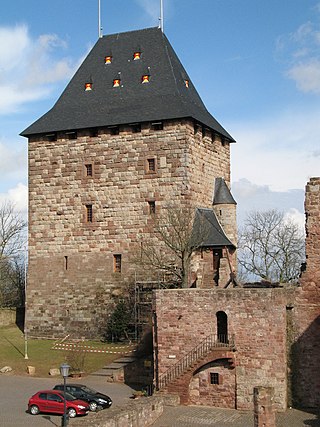Mayen-Koblenz is a district (Kreis) in the north of Rhineland-Palatinate, Germany. Neighboring districts are Ahrweiler, Neuwied, Westerwaldkreis, district-free Koblenz, Rhein-Lahn, Rhein-Hunsrück, Cochem-Zell, and Vulkaneifel.

Mayen is a town in the Mayen-Koblenz District of the Rhineland-Palatinate Federal State of Germany, in the eastern part of the Volcanic Eifel Region. As well as the main town, additional settlements include Alzheim, Kürrenberg, Hausen-Betzing, Hausen and Nitztal. Mayen is the administrative centre of the Vordereifel ‘Collective Municipality’, although it is not part of the municipality.

Sooneck Castle is a castle in the upper middle valley of the Rhine, in the Mainz-Bingen district of Rhineland-Palatinate, Germany. It is located near the village of Niederheimbach between Bingen and Bacharach.

Lissingen Castle is a well-preserved former moated castle dating to the 13th century. It is located on the River Kyll in Gerolstein in the administrative district of Vulkaneifel in Rhineland-Palatinate, Germany. From the outside it appears to be a single unit, but it is a double castle; an estate division in 1559 created the so-called lower castle and upper castle, which continue to have separate owners. Together with Bürresheim and Eltz, it has the distinction among castles in the Eifel of never having been destroyed.

Lindheim Castle is a former medieval castle in Lindheim, in the municipality of Altenstadt, Wetteraukreis county, in the German state of Hesse. In the Middle Ages the castle became a large joint inheritance or Ganerbschaft of lesser noble families, who were an important local power in the eastern Wetterau. In 1697, stately home, Schloss Lindheim, was built. Only a few remnants of both buildings have survived today.

Saaleck Castle is a hill castle near Bad Kösen, now a part of Naumburg, Saxony-Anhalt, Germany.

The Eifel Club is one of the largest rambling clubs in Germany with a membership of 28.000. Its purpose is the "maintenance of local customs, the protection and care of monuments to which it is particularly committed".

The ruins of the Thurant Castle stand on a wide slate hill spur above the villages of Alken on the Moselle in Germany. The castle is in the district of Mayen-Koblenz in Rhineland-Palatinate and belongs to the spur castle type. Vine gardens on the sunniest slope.

Zwingenberg Castle, also called Zwingenberg or Schloss Zwingenberg, stands on the right bank of the River Neckar where it cuts through the Odenwald hills in central Germany. The castle is located in the municipality of Zwingenberg in the state of Baden-Württemberg.

The Wildenburg lies in the North Rhine-Westphalian part of the Eifel Mountains in the national park district of Hellenthal in the German county of Euskirchen.

Pyrmont Castle stands west of Münstermaifeld near Roes and Pillig on a slate rock outcrop above a waterfall on the Elzbach in the southern Eifel mountains in Germany. It is in the municipality of Roes in the district of Cochem-Zell.

The ruins of Ramstein Castle stand on a 182-metre-high, Bunter sandstone rock on the edge of the Meulenwald forest in the lower, steep-sided Kyll valley near Kordel in the German state of Rhineland-Palatinate. It stands 9 kilometres (5.6 mi) north of Trier and the same east of Luxembourg.

Wernerseck Castle, also called the Kelterhausburg, is a late medieval hill castle in the municipality of Ochtendung in the county of Mayen-Koblenz in the German state of Rhineland-Palatinate. It owes its name to its founder and lord of the castle, the Archbishop of Trier, Werner of Falkenstein (1388–1418). "Wernerseck" means "Werner's corner".

On a hill spur above the Eifel village of Monreal in Germany's Elzbach valley, at a height of 350 m above sea level (NHN), stand two neighbouring ruined hill castles: the Löwenburg, also called Monreal Castle, and the Philippsburg. The latter is also known locally as das Rech.

The Castle Museum is located in Nideggen Castle in the county of Düren, in the German state of North Rhine-Westphalia.

The ruins of Nideggen Castle are a symbol of the town of Nideggen in Germany and are owned by the county of Düren. The rectangular hill castle was the seat of the powerful counts and dukes of Jülich and had a reputation in the Middle Ages of being impregnable.

The Oberburg at Kobern, also called the Oberburg or Altenburg, is a hill castle above the municipality of Kobern-Gondorf in the county of Mayen-Koblenz in the German state of Rhineland-Palatinate.

The Castle of Linz is a castle in Linz am Rhein, Germany, built between 1364 and 1368 by Heinrich von Virneburg, who was the archbishop of Cologne at the time. The main function of the castle was to collect river tolls. During the Neuss War in 1475, the castle was besieged and badly damaged. From 1811 to 1851, it served as a prison. The castle lost its importance when the town of Linz am Rhein was sold to Prussia in 1820. In 1942–1945, during the Second World War, the castle was once again used as a prison. The structure today is now privately owned and used as a public venue.

















